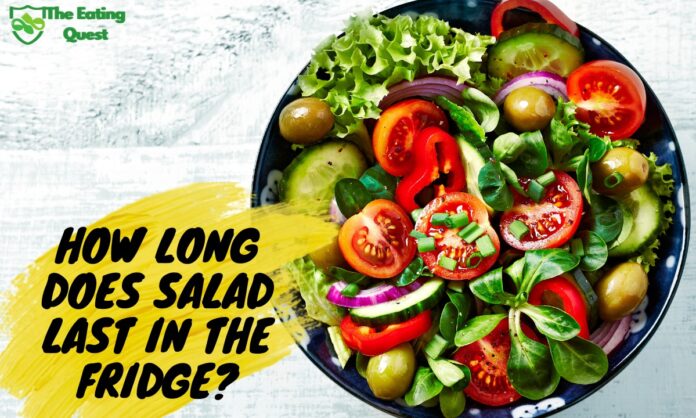Have you ever wondered how long your leftover salad will last in the fridge? It’s a common question, and the answer depends on a few factors. In this article, we’ll explore how long different types of salads can last in the fridge, and what you can do to extend their shelf life.
The shelf life of salad can vary depending on a few different factors. The type of salad, the ingredients used, and how it’s stored all play a role in determining how long it will stay fresh. Generally speaking, most salads will last between 3-5 days in the fridge.
However, some salads may last longer or shorter than this depending on the factors mentioned above. In the following paragraphs, we’ll take a closer look at how long different types of salads can last in the fridge, and what you can do to keep them fresh for as long as possible.
How Long Does Salad Last in the Fridge with Dressing
When it comes to storing salad with dressing in the fridge, the shelf life can vary depending on the ingredients used and the type of dressing added. Generally, a salad with dressing can last in the fridge for 3-5 days if stored properly.
To ensure your salad stays fresh for as long as possible, it’s important to follow some basic guidelines. First, make sure your salad is completely dry before adding dressing. Excess moisture can cause the salad to wilt and spoil faster. Second, use airtight containers or plastic wrap to cover your salad and prevent air from getting in. Lastly, keep your salad in the coldest part of the fridge, typically the back, to maintain freshness.
If you’re using a creamy dressing such as ranch or Caesar, your salad may not last as long due to the dairy content. In this case, it’s best to consume your salad within 2-3 days. On the other hand, vinaigrette dressings tend to last longer and can extend the shelf life of your salad to 4-5 days.
It’s important to note that while your salad may still be safe to eat after the recommended storage time, it may not taste as fresh and the quality may have declined. Always use your best judgment and inspect the salad before consuming. If it looks or smells off, it’s best to err on the side of caution and discard it.
In summary, a salad with dressing can last in the fridge for 3-5 days if stored properly. Use airtight containers, keep it in the coldest part of the fridge, and consume within the recommended time frame for best results.
How Long Is Salad Good For
When it comes to salads, the shelf life can vary depending on the type of salad, ingredients used, and storage conditions. Here’s a general guideline on how long different types of salads can last in the fridge:
- Leafy green salads: These salads typically last for 3-5 days when stored in an airtight container in the fridge. However, if you notice any wilting or sliminess, it’s best to discard the salad.
- Pasta and potato salads: These salads can last for up to 5 days in the fridge when stored in an airtight container. However, if the salad has been sitting out at room temperature for more than 2 hours, it’s best to discard it.
- Fruit salads: These salads can last for up to 2-3 days in the fridge when stored in an airtight container. However, if the fruits start to look brown or mushy, it’s best to discard the salad.
- Egg and chicken salads: These salads can last for up to 3-4 days in the fridge when stored in an airtight container. However, if the salad has been sitting out at room temperature for more than 2 hours, it’s best to discard it.
It’s important to note that the above guidelines are just a general rule of thumb. Always use your best judgment when it comes to food safety. If you’re unsure about the freshness of a salad, it’s better to err on the side of caution and discard it. Additionally, be sure to store your salads in airtight containers to help prolong their shelf life.
Signs of Spoilage in Salad
When storing salad, it’s essential to keep an eye out for signs of spoilage. Here are some common indicators that your salad may have gone bad:
- Slimy texture: If your salad feels slimy or slippery, this is a clear sign that bacteria have started to grow on the leaves. This texture is often accompanied by a foul odor.
- Mold or discoloration: If you notice any mold or dark spots on your salad leaves, it’s best to discard them immediately. Mold can spread quickly and contaminate the entire salad.
- Unpleasant odor: If your salad has a sour or unpleasant smell, this is a sign that bacteria have started to break down the leaves. Fresh salad should have a crisp, clean smell.
- Wilted leaves: If your salad leaves are wilted or limp, this could be a sign that they are past their prime. While they may not be spoiled, they may not taste as fresh as they should.
To avoid consuming spoiled salad, it’s essential to store it properly and check it regularly for signs of spoilage. If you notice any of the above indicators, it’s best to err on the side of caution and discard the salad.

How to Keep Salad Fresh
When it comes to keeping your salad fresh, there are a few things you can do to extend the life of your greens. Here are some tips to help keep your salad fresh and crisp for longer.
Refrigeration
Refrigeration is key to keeping your salad fresh. Store your salad in the fridge as soon as possible after making it. If you bought a pre-packaged salad, make sure to check the expiration date before storing it in the fridge.
Sealing
Sealing your salad is another important step to keeping it fresh. Store your salad in an airtight container or resealable bag to prevent air from getting in and causing your greens to wilt. You can also place a paper towel in the container or bag to absorb any excess moisture.
Placement in the Fridge
Where you place your salad in the fridge can also make a difference in how long it stays fresh. Keep your salad away from the back of the fridge where it can get too cold and freeze. Instead, store it in the middle or top shelf of the fridge where the temperature is more consistent.
Remember to always check your salad for any signs of spoilage before eating it. If it smells or looks off, it’s best to toss it out and make a fresh batch. With these tips, you can enjoy fresh and delicious salads all week long.
Implications of Consuming Spoiled Salad
Eating spoiled salad can lead to various health implications, ranging from mild to severe. Here are some of the potential risks associated with consuming spoiled salad:
- Food poisoning: When salad greens are left in the fridge for too long, they can become contaminated with bacteria such as Salmonella, E. coli, and Listeria. These bacteria can cause food poisoning, which can lead to symptoms such as nausea, vomiting, diarrhea, and fever.
- Mold toxicity: If you notice mold growing on your salad greens, it’s best to discard them immediately. Mold can produce mycotoxins, which can cause a range of health problems, including respiratory issues, headaches, and even cancer.
- Nutrient loss: As salad greens start to spoil, they lose their nutritional value. This means that you may not be getting the full benefit of the vitamins and minerals that the salad would have provided if it were fresh.
To avoid these health implications, it’s important to store your salad properly and consume it before it goes bad. Make sure to check the expiration date on any pre-packaged salad greens, and always wash your salad thoroughly before eating it. If you notice any signs of spoilage, such as discoloration or a foul odor, discard the salad immediately.
Conclusion
You now have a good understanding of how long salad lasts in the fridge. Remember that the shelf life of your salad depends on various factors such as the ingredients, the storage temperature, and the type of container you use to store it.
To maximize the shelf life of your salad, it is advisable to store it in an airtight container in the fridge at a temperature of 40°F or below. This will help to slow down the growth of bacteria and keep your salad fresh for longer.
If you notice any signs of spoilage such as a slimy texture or a strange odor, it is best to discard the salad. Eating spoiled food can lead to food poisoning and other health issues.
To prevent food waste, it is recommended to prepare only the amount of salad that you will consume within a few days. This will also ensure that you are always eating fresh and nutritious food.
By following the tips and guidelines outlined in this article, you can enjoy delicious and healthy salads for days to come.
Frequently Asked Questions
How long can a prepared salad last in the fridge?
Prepared salads can last up to 3-5 days in the fridge, depending on the ingredients used. Leafy greens tend to wilt faster, while heartier vegetables like carrots and cucumbers can last longer. It’s important to store your salad in an airtight container to keep it fresh.
What is the best container to keep salad fresh?
The best container to keep salad fresh is an airtight container. Glass containers with locking lids or plastic containers with tight-fitting lids work well. Avoid using containers that are too big, as they can allow more air in and cause the salad to wilt faster.
Can you eat leftover salad with dressing?
Yes, you can eat leftover salad with dressing, but it’s best to keep the dressing separate until you’re ready to eat. Mixing the dressing with the salad can cause it to become soggy and wilted. If you’re packing a salad for lunch, consider using a small container for the dressing and adding it right before eating.
How long does homemade salad dressing last in the fridge?
Homemade salad dressing can last up to 2 weeks in the fridge, depending on the ingredients used. If you’re unsure about the freshness of your homemade dressing, give it a sniff and a taste before using it. If it smells off or tastes sour, it’s best to toss it out.
How long does salami last in the fridge?
Salami can last up to 3 weeks in the fridge if it’s unopened and stored properly. Once opened, it should be consumed within 1-2 weeks. It’s important to store salami in an airtight container or wrapped tightly in plastic wrap to prevent it from drying out.
Is it safe to eat salad after 7 days?
It’s not recommended to eat salad after 7 days, as it can become contaminated with harmful bacteria. It’s best to consume your salad within 3-5 days to ensure its freshness and safety. If you’re unsure about the freshness of your salad, give it a sniff and a taste before eating. If it smells off or tastes sour, it’s best to toss it out.
Also Read:
















